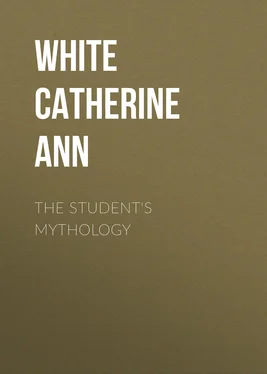Catherine White - The Student's Mythology
Здесь есть возможность читать онлайн «Catherine White - The Student's Mythology» — ознакомительный отрывок электронной книги совершенно бесплатно, а после прочтения отрывка купить полную версию. В некоторых случаях можно слушать аудио, скачать через торрент в формате fb2 и присутствует краткое содержание. Издательство: Иностранный паблик, Жанр: foreign_prose, foreign_religion, Философия, foreign_psychology, foreign_antique, на английском языке. Описание произведения, (предисловие) а так же отзывы посетителей доступны на портале библиотеки ЛибКат.
- Название:The Student's Mythology
- Автор:
- Издательство:Иностранный паблик
- Жанр:
- Год:неизвестен
- ISBN:нет данных
- Рейтинг книги:4 / 5. Голосов: 1
-
Избранное:Добавить в избранное
- Отзывы:
-
Ваша оценка:
- 80
- 1
- 2
- 3
- 4
- 5
The Student's Mythology: краткое содержание, описание и аннотация
Предлагаем к чтению аннотацию, описание, краткое содержание или предисловие (зависит от того, что написал сам автор книги «The Student's Mythology»). Если вы не нашли необходимую информацию о книге — напишите в комментариях, мы постараемся отыскать её.
The Student's Mythology — читать онлайн ознакомительный отрывок
Ниже представлен текст книги, разбитый по страницам. Система сохранения места последней прочитанной страницы, позволяет с удобством читать онлайн бесплатно книгу «The Student's Mythology», без необходимости каждый раз заново искать на чём Вы остановились. Поставьте закладку, и сможете в любой момент перейти на страницу, на которой закончили чтение.
Интервал:
Закладка:
Ques. Can you name any works of Vulcan, beside those already mentioned?
Ans. Yes, he made for Alcinoûs, king of the Phæacians, gold and silver dogs which guarded his house. To Minos, king of Crete, he gave the brazen man Talus, who passed around the island three times every day, to guard it from invasion. For himself, Vulcan formed golden handmaidens, whom he endowed with reason and speech.
CHAPTER XIV
Ques. Who was Æ´olus?
Ans. He was the god of the winds; he could imprison them in a dark cave, or, by setting them free, create tempests.
Ques. What was the origin of this fable?
Ans. It is believed that Æ´olus was a skillful astronomer who dwelt in a volcanic island. By noticing the clouds of smoke, and how they rose, he was enabled to foretell storms a long time before they happened; hence the ignorant believed that he could bring high winds and tempests whenever he pleased.
Ques. Who was Momus?
Ans. He was the son of Night and Sleep; the name Momus signifies a jester. His occupation was to criticise the other gods, and censure their actions.
Ques. Give an example?
Ans. Neptune, Vulcan, and Minerva contended for the prize of skill; Neptune made a bull, Minerva a house, and Vulcan a man. Momus was called upon to decide their merits, but he blamed them all. He said that Neptune was imprudent in not placing the bull’s horns in his forehead, before his eyes, that he might give a stronger and surer blow. He found fault with Minerva’s house, because it was immovable and could not be carried away if it were placed among bad neighbors. He said that Vulcan was the worst of all, because he did not put a window in the man’s breast so that his thoughts might be seen. No god could escape the censure of Momus. When he could find nothing to criticise in the person of Venus, he complained of the noise made by her golden sandals. Momus was at length driven from Olympus.
CHAPTER XV
Ques. Who was Vesta?
Ans. She was the daughter of Saturn and Ops or Rhea, and was, therefore, the sister of Jupiter. She was considered the guardian of homes and firesides, and was a household divinity. Statues of Vesta were placed by the Romans at the entrance of their houses; hence the word vestibule, which we still use.
Ques. How is Vesta usually represented?
Ans. As seated on the ground, and leaning upon a drum, while various domestic animals are grouped about her.
Ques. What was the character of this goddess?
Ans. She was esteemed very holy, and was the patroness of household virtues. When Jupiter asked her to choose whatever gift she would, Vesta desired that she might remain always a virgin, and receive the first oblations in all sacrifices. Fire was the emblem of this goddess, and in her temple, at Rome, a sacred fire was suspended in the air, and watched by the Vestal Virgins. If this fire chanced to be extinguished, all public and private business was suspended until the accident had been expiated.
Ques. What laws existed with regard to the Vestal Virgins?
Ans. The penalties for neglect of their duties were severe. If the sacred fire was extinguished through their negligence, they were sometimes cruelly punished, and if any Virgin infringed the rule which forbade her to marry, she was buried alive; being shut up in a vault underground, with a lamp, and a little bread, wine, water and oil. The sacred fire of Vesta was watched by these priestesses for nearly eleven centuries. We are told that during this period, twenty Vestals were condemned to death. Of these, seven were permitted to take their own lives, thirteen suffered the terrible punishment we have described. The last execution of this kind took place in the reign of the emperor Domitian.
Ques. What were the privileges of the Vestal Virgins?
Ans. In recompense for these severe laws, the Vestals were treated with extraordinary respect. They had the most honorable seats at games and festivals, and even the consuls and magistrates gave them precedence; their testimony was taken in trials without any form of oath, and if they happened to meet a criminal going to execution, he was immediately pardoned. Public documents of great importance were generally entrusted to their care.
A striking instance of the respect felt for these Virgins, is related by a Roman historian. Appius Claudius Audax, a consul who had rendered himself obnoxious to the people, was attacked in the midst of a triumphal procession by the plebeian tribunes, who endeavored to pull him from his chariot. His daughter, who was a Vestal Virgin, ascended the triumphal car, and took her place by her father’s side. The tumult immediately subsided, and the procession proceeded quietly to the capital.
Ques. How many Vestal Virgins were there?
Ans. The number has been variously stated. Some authors mention six, others seven, as the number actually in office. They were chosen between the ages of six and ten; for ten years they were employed in learning their duty; they remained in office for ten, and ten other years were employed in instructing the novices. If there were seven Vestals always in office, the entire number must have been twenty-one. The thirty years being ended, the Vestals returned to their families. The law then permitted them to marry, but it was considered discreditable to do so.
CHAPTER XVI
Ques. Who was Cyb´ele?
Ans. This goddess, sometimes called by the Greeks, Rhea, and by the Latins, Ops, is considered to be a personification of the earth. She is goddess, not of cities only, but of all things which the earth contains. She was the daughter of Cœlum, and the wife of Saturn.
Ques. How was Cyb´ele represented?
Ans. Generally as riding in a chariot, drawn by lions. She wears a turreted crown, and is clothed in a many-colored mantle, on which are represented the figures of various animals. In her right hand she holds a sceptre, and in her left, a key. This last emblem seems to signify that the earth locks up her treasures in the winter season. Cyb´ele is always represented with the dignified and matronly air which distinguishes Juno and Ceres.
Ques. How was she worshipped?
Ans. Sacrifices were first offered to this goddess in Phrygia and Lydia. Her temples were generally built on the summits of mountains; that on Mount Dindymus near Pessi´nus, in Galatia, was particularly celebrated. Her statue in this temple was simply a large aerolite which had fallen in the vicinity, and was regarded by the people as the heaven-sent image of their great goddess. At the close of the second Punic war, the Romans, directed, it is said, by the Sibylline books, sent an embassy to Attalus, king of Pergamus, requesting that he would permit the so-called image to be removed to Rome. The monarch consented, and the sacred stone was carried in triumph to the Italian capital. There it was placed in a stately temple built for the purpose, and a solemn festival, called Megalesia, was celebrated annually, in honor of Cyb´ele. During these solemnities, priests called Galli and Corybantes ran about like madmen, with cries and howlings, making, at the same time, a terrific noise with the clashing of cymbals, the sound of pipes and other instruments. In their frenzy, they cut their flesh with knives, and performed many other extravagances, but the people regarded them with reverence, as they were believed, while in this state, to possess the gift of prophecy.
Читать дальшеИнтервал:
Закладка:
Похожие книги на «The Student's Mythology»
Представляем Вашему вниманию похожие книги на «The Student's Mythology» списком для выбора. Мы отобрали схожую по названию и смыслу литературу в надежде предоставить читателям больше вариантов отыскать новые, интересные, ещё непрочитанные произведения.
Обсуждение, отзывы о книге «The Student's Mythology» и просто собственные мнения читателей. Оставьте ваши комментарии, напишите, что Вы думаете о произведении, его смысле или главных героях. Укажите что конкретно понравилось, а что нет, и почему Вы так считаете.












